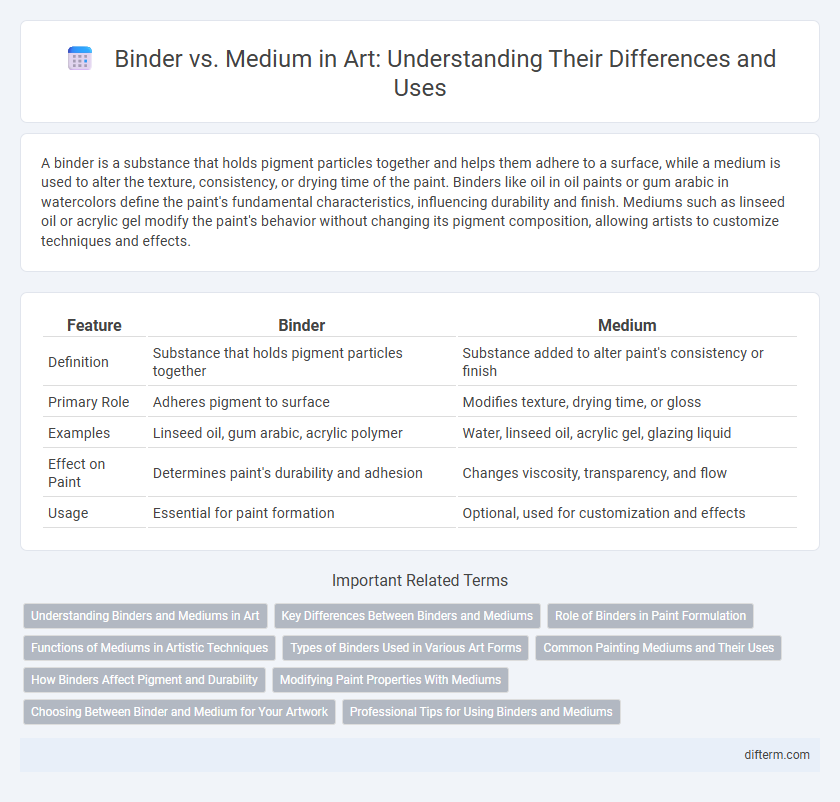A binder is a substance that holds pigment particles together and helps them adhere to a surface, while a medium is used to alter the texture, consistency, or drying time of the paint. Binders like oil in oil paints or gum arabic in watercolors define the paint's fundamental characteristics, influencing durability and finish. Mediums such as linseed oil or acrylic gel modify the paint's behavior without changing its pigment composition, allowing artists to customize techniques and effects.
Table of Comparison
| Feature | Binder | Medium |
|---|---|---|
| Definition | Substance that holds pigment particles together | Substance added to alter paint's consistency or finish |
| Primary Role | Adheres pigment to surface | Modifies texture, drying time, or gloss |
| Examples | Linseed oil, gum arabic, acrylic polymer | Water, linseed oil, acrylic gel, glazing liquid |
| Effect on Paint | Determines paint's durability and adhesion | Changes viscosity, transparency, and flow |
| Usage | Essential for paint formation | Optional, used for customization and effects |
Understanding Binders and Mediums in Art
Binders in art serve as the adhesive agents that hold pigment particles together and ensure they adhere to the painting surface, with common examples including linseed oil in oil paints and gum arabic in watercolors. Mediums, on the other hand, are substances mixed with paint to modify its consistency, drying time, or finish, such as turpentine used to thin oil paint or acrylic mediums that can add texture or gloss. Understanding the distinction between binders and mediums is essential for artists aiming to control the durability, texture, and visual effects of their artwork effectively.
Key Differences Between Binders and Mediums
Binders are substances that hold pigment particles together and adhere them to a surface, ensuring the paint's durability and texture, while mediums modify the paint's consistency, drying time, and finish without altering pigment binding. Key differences include that binders form the fundamental structure of the paint film, such as linseed oil in oil paints or gum arabic in watercolors, whereas mediums like glazing liquids or retarding agents adjust working properties and effects. Understanding these distinctions is essential for artists aiming to control paint behavior and achieve desired visual outcomes.
Role of Binders in Paint Formulation
Binders in paint formulation serve as the essential component that holds pigment particles together, ensuring adhesion to the painting surface and durability of the artwork. Unlike mediums, which artists alter for texture and drying time, binders provide the fundamental film-forming property vital for paint integrity. Common binders include acrylic polymer emulsions, oil in oil paints, and gum arabic in watercolors, each influencing the final finish and longevity of the piece.
Functions of Mediums in Artistic Techniques
Mediums in artistic techniques serve to alter the texture, drying time, and overall appearance of pigments, enhancing the artist's ability to manipulate color and consistency. Unlike binders, which primarily hold pigment particles together and attach them to a surface, mediums modify the working properties of paints, such as increasing transparency, gloss, or flow. Common mediums include linseed oil for oil painting and acrylic polymer for acrylics, each enabling specific effects that contribute to the final artwork's expression and durability.
Types of Binders Used in Various Art Forms
Types of binders used in various art forms include natural gums like Arabic gum in watercolor paints, which bind pigment particles and create a smooth texture. Oil painters rely on linseed oil as a binder to enhance pigment flow and provide durability. Acrylic artists use synthetic polymer emulsions that dry quickly and form a flexible, water-resistant film essential for vibrant color retention.
Common Painting Mediums and Their Uses
Common painting mediums include linseed oil, which enhances drying time and gloss for oil paints, and acrylic polymer emulsion, used to modify the texture and drying speed of acrylic paints. Binders like gum arabic in watercolors secure pigments to the surface, creating a transparent finish, while mediums such as alkyd improve flexibility and durability in oil paintings. Each medium alters the paint's consistency and drying properties, directly impacting the artwork's final appearance and longevity.
How Binders Affect Pigment and Durability
Binders play a crucial role in determining how pigments adhere to surfaces and influence the overall durability of artwork. They encapsulate pigment particles, affecting the paint's texture, color intensity, and resistance to environmental factors such as light and moisture. High-quality binders like acrylic polymer or linseed oil enhance pigment dispersion and create a stable film that preserves the artwork's longevity over time.
Modifying Paint Properties With Mediums
Mediums alter paint properties by adjusting texture, drying time, and finish, enhancing artists' control over their work. Binders, such as oil or acrylic polymer, hold pigment particles together and adhere paint to the surface, providing the foundational structure. Understanding the distinction between binders and mediums is essential for manipulating viscosity, transparency, and durability in fine art painting.
Choosing Between Binder and Medium for Your Artwork
Choosing between a binder and a medium for your artwork hinges on the desired texture, adhesion, and drying time. Binders, such as acrylic polymer or gum arabic, serve as the essential adhesive that holds pigments together and attaches them to the support surface. Mediums, like linseed oil or glazing liquid, modify the paint's consistency, transparency, and drying properties to enhance the visual effects and durability of the artwork.
Professional Tips for Using Binders and Mediums
Binders, such as acrylic polymer or gum arabic, provide adhesion and film formation in paint, while mediums adjust consistency, drying time, and finish without compromising color integrity. Professional artists select binders based on paint type and surface compatibility, ensuring optimal durability and flexibility in their work. Mastering the balance between binder and medium enhances texture control and longevity, vital for both fine details and large-scale compositions.
binder vs medium Infographic

 difterm.com
difterm.com